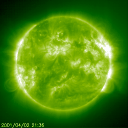
SUN-EARTH DAY
Armagh Observatory, 26 April 2001:
 The European Space Agency is promoting the first Sun-Earth Day on 27 April 2001, by pondering our planet's links with our nearest star. Studies of the Sun from ground and space observatories provide valuable information which can impact on our daily lives. Armagh Observatory will hold an Open Day to mark this event later in the year.
The European Space Agency is promoting the first Sun-Earth Day on 27 April 2001, by pondering our planet's links with our nearest star. Studies of the Sun from ground and space observatories provide valuable information which can impact on our daily lives. Armagh Observatory will hold an Open Day to mark this event later in the year.
The Sun plays a central role in all our lives, warming and lighting the world, and powering the growth of plants. Since ancient times, mankind has been aware of its importance, although not always understanding how or why. Now, in the space age, artificial satellites monitor and probe the environment of the Sun, observing the subtle day to day changes and the sometimes-damaging effects on Earth. The study of "space weather", the collective term used to describe effects originating from the Sun, is an increasingly important activity in our technology-dependent society.
Nuclear reactions deep inside the Sun create the light and heat we need for our survival. Four million tonnes of its matter are lost every second to space through radiation by the conversion of hydrogen to helium. However, the Sun is so large that even with this rate of mass loss it will continue to shine for at least another five billion years. Near the end of its life it will expand into a red giant, causing Earth's oceans to boil away and destroying all life on our planet.
The Aurora Borealis, or Northern Lights, appear when eruptions on the Sun disturb the Earth's space environment. These solar storms can be troublesome to modern technology, endangering astronauts, satellites, ground communications and power supplies. Travelling at the speed of light, about 300,000 kilometres per second, flashes of X-rays and ultraviolet rays from the Sun reach Earth after some 8 minutes. The energetic particles (mostly protons and electrons) emitted by the solar storms travel much more slowly - only about 1000 km per second - and arrive at the Earth 2 or 3 days later. Interacting with the Earth's magnetic field and ionosphere, they cause disturbances that can interrupt short-wave radio transmissions and interfere with navigation systems.
Examples of recent events include the large solar eruption of 2 April this year, the biggest on record, and more powerful than the famous 6 March 1989 flare that resulted in the disruption of the power grids in Canada. Fortunately, the Earth was not directly in the line-of-fire during this month's flare, so the effects were less severe. The flare was associated with the largest sunspot group for 10 years, and it caused aurorae to be visible from as far south as Mexico. The same massive sunspot will be visible again as we celebrate Sun-Earth Day on 27 April.
The ability to forecast space weather can alert us to forthcoming storms allowing appropriate action to be taken to minimise the damage. An improved understanding of the Sun has come from a number of highly successful European satellites. These include the Solar Heliospheric Observatory (SOHO), the four satellites known as Cluster orbiting in formation around the Earth, and Ulysses which is in an orbit that takes it over the north and south poles of the Sun. Astronomers at Armagh Observatory are also investigating links between solar activity and climate change using data from SOHO.
For information on space weather see the WEB page: http://sohowww.nascom.nasa.gov/spaceweather/ or
Armagh Observatory's page: http://www.arm.ac.uk/climate/intro.html.
For recent solar images see http://sohowww.nascom.nasa.gov/data/realtime-images.html
See also the Space Environment Center
FOR FURTHER INFORMATION CONTACT Professor Gerry Doyle or John McFarland at the Armagh Observatory, tel.: 028-3752-2928.

| Last Revised: 2001 April 26th WWW contact: webmaster@star.arm.ac.uk |
Go to HOME Page  |